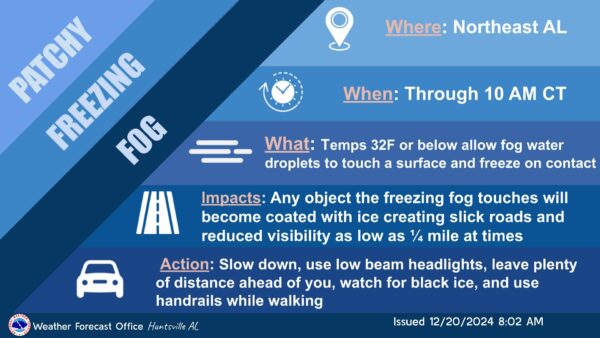Special Weather Statement: Areas of Dense Fog and Possible Freezing Fog Across Parts of Northeast Alabama
Thick fog has developed across parts of NE Alabama. Visibilities are down to 1/4 of mile or less for places like Scottsboro, Arab and Rainsville. A special weather statement has been posted by the National Weather Service for Marshall, Jackson and DeKalb Counties.
For areas that have not yet seen temperatures climb above freezing, there could be patchy freezing fog. That means the areas of mist and drizzle could freeze on colder surfaces like bridges and overpasses.
Take it easy if you are heading out over the next few hours. Give yourself extra time to get to your destination. A varying degree of visibility expected through mid to late morning. And there could be patch slick spots due to black ice.
Special Weather Statement
National Weather Service Huntsville AL
758 AM CST Fri Dec 20 2024
ALZ008>010-201600-
Marshall-Jackson-DeKalb-
Including the cities of Albertville, Boaz, Guntersville, Arab,
Scottsboro, Fort Payne, and Rainsville
758 AM CST Fri Dec 20 2024
…Patchy Dense Fog possible for Northeast Alabama…
Patchy Dense Fog has developed across portions of Northeast Alabama,
with visibilities dropping to 1/4 mile or less in isolated areas.
Some patchy freezing fog is possible as well where temperatures are
still below freezing.
Motorists are urged to drive with extreme caution, as visibilities
will vary significantly given the patchy nature of the fog. Use low
beams, reduce driving speed, and allow for plenty of room between
you and other cars.
The fog should begin to burn off by 10 AM CST
Stay tuned to NOAA Weather Radio, or a favorite local media outlet,
for further statements or updates from the National Weather Service
in Huntsville.
Category: Alabama's Weather, ALL POSTS, Severe Weather, Social Media
















